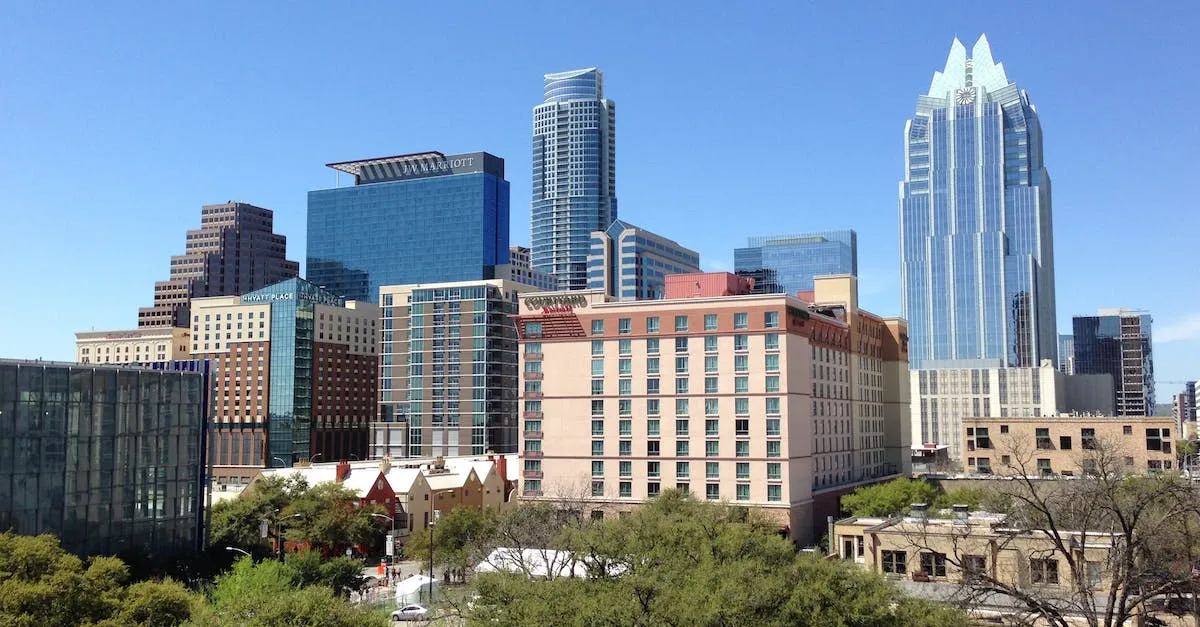The Least Humid Cities In Texas
Texas is known for many things – wide open spaces, cowboy culture, barbecue – but humid summers are high on the list. However, some parts of the Lone Star State offer respite from the sticky, sweaty heat. If you’re looking to escape the humidity in Texas, consider these less muggy cities.
If you’re short on time, here are some of the least humid cities in Texas: El Paso, Amarillo, Lubbock, Midland, and Abilene.
In this comprehensive guide, we’ll explore major cities in Texas that see the lowest humidity levels in the summer. We’ll compare humidity data across the state, discuss why certain areas are less humid, and help you find the best place to beat the Texas heat.
Texas Cities with the Lowest Humidity Levels
El Paso – 28% average summer humidity
El Paso, located in the westernmost part of Texas, boasts one of the lowest humidity levels in the state. With an average summer humidity of just 28%, residents of El Paso enjoy dry and comfortable conditions.
The arid climate and proximity to the desert contribute to the low humidity levels in this city. Visitors and residents alike can take advantage of the pleasant weather to explore the city’s outdoor attractions, such as the Franklin Mountains State Park or the El Paso Zoo.
Amarillo – 33% average summer humidity
Amarillo, situated in the Texas Panhandle, experiences relatively low humidity levels compared to other cities in the state. With an average summer humidity of 33%, residents of Amarillo can enjoy a drier climate.
The city’s location in a region known for its wide-open spaces and vast plains contributes to the lower humidity levels. Visitors to Amarillo can take in the breathtaking beauty of the Palo Duro Canyon State Park or visit the famous Cadillac Ranch.
Lubbock – 36% average summer humidity
Lubbock, often referred to as the “Hub City,” is known for its lower humidity levels compared to other parts of Texas. With an average summer humidity of 36%, residents of Lubbock can enjoy a more comfortable climate.
The city’s location in the semi-arid region of West Texas contributes to the lower humidity levels. Lubbock offers a variety of attractions, including the National Ranching Heritage Center and the Buddy Holly Center, celebrating the rock ‘n’ roll legend who was born in the city.
Midland – 39% average summer humidity
Midland, located in the Permian Basin of West Texas, experiences relatively low humidity levels compared to other cities in the state. With an average summer humidity of 39%, residents of Midland can enjoy a drier climate.
The city’s location in the arid region of West Texas contributes to the lower humidity levels. Midland offers a range of activities, including the Permian Basin Petroleum Museum and the George W. Bush Childhood Home, providing visitors with a glimpse into the area’s history and culture.
Abilene – 41% average summer humidity
Abilene, situated in the central part of Texas, experiences lower humidity levels compared to many other cities in the state. With an average summer humidity of 41%, residents of Abilene can enjoy a more comfortable climate.
The city’s location on the edge of the West Texas plains contributes to the lower humidity levels. Abilene offers a variety of attractions, including the Frontier Texas! museum and the Abilene Zoo, providing entertainment for visitors and residents alike.
Why West Texas Sees Less Humidity
West Texas is known for its dry climate and low humidity levels. There are several factors that contribute to this phenomenon, making it one of the least humid regions in the state.
Farther from the Gulf of Mexico
Unlike cities on the eastern coast of Texas, which are in close proximity to the Gulf of Mexico, West Texas cities are farther inland. This distance from the coast means that the humid air coming from the Gulf has less of an impact on the region.
As a result, these cities experience lower humidity levels throughout the year.
At higher elevations
Another reason for the lower humidity in West Texas is the higher elevation of the region. Cities such as El Paso and Lubbock are situated at higher altitudes compared to other parts of the state. Higher altitudes generally have lower humidity levels due to the cooler temperatures and thinner air.
This combination helps to reduce the overall moisture in the atmosphere.
In the rainshadow of mountains/plateaus
Many parts of West Texas are located in the rainshadow of mountains and plateaus. When prevailing winds carrying moisture from the Gulf encounter these geographic features, they are forced to rise and cool.
As the air rises, it loses its ability to hold moisture, resulting in less rainfall and lower humidity levels in the areas to the west.
Less vegetation and bodies of water
Compared to other regions in Texas, West Texas has less vegetation and fewer bodies of water. Vegetation, such as trees and plants, release moisture into the air through a process called transpiration.
Bodies of water, such as lakes and rivers, also contribute to humidity by evaporating water into the atmosphere. With less vegetation and fewer bodies of water, the amount of moisture in the air is significantly reduced, leading to lower humidity levels in West Texas.
The Most Humid Parts of Texas
While Texas is known for its hot and dry climate, there are certain regions within the state that experience higher levels of humidity. These areas tend to have a more tropical feel, with lush vegetation and a higher chance of rainfall.
Let’s take a closer look at some of the most humid parts of Texas.
Houston and East Texas
When it comes to humidity, Houston and the surrounding areas in East Texas take the crown. With its proximity to the Gulf of Mexico, Houston experiences high levels of moisture in the air. The city has a subtropical climate, characterized by hot, humid summers and mild winters.
The humidity in Houston can be felt throughout the year, but it tends to peak during the summer months.
In addition to Houston, cities like Beaumont, Galveston, and Port Arthur also experience high levels of humidity due to their coastal location. The humidity in these areas can make summers feel especially sticky, but it also contributes to the region’s lush greenery and vibrant ecosystem.
Dallas-Fort Worth and North Texas
While not as humid as Houston, the Dallas-Fort Worth metroplex and other parts of North Texas still experience a fair amount of humidity. This region has a humid subtropical climate, with hot, humid summers and mild winters.
The humidity in North Texas is influenced by its proximity to the Gulf Coast and the moisture-laden air masses that travel up from the south.
Cities like Dallas, Fort Worth, and Arlington can experience high humidity levels, particularly during the summer months. However, the region also benefits from a higher average wind speed, which helps to alleviate some of the discomfort caused by the humidity.
Austin and Central Texas
Austin and Central Texas may not be as humid as Houston or North Texas, but they still have their fair share of muggy days. The region has a humid subtropical climate, with hot summers and mild winters. The humidity in Central Texas is influenced by the moist air coming from the Gulf of Mexico.
While the humidity in Austin and surrounding areas is not as high as in other parts of the state, it can still be felt during the summer months. However, the city’s vibrant music scene, outdoor activities, and beautiful natural attractions more than make up for any discomfort caused by the humidity.
San Antonio and South Texas
San Antonio and South Texas also experience significant levels of humidity, although not as high as Houston or East Texas. The region has a hot semi-arid climate, with hot, humid summers and mild winters. The humidity in South Texas is influenced by its proximity to the Gulf of Mexico.
Cities like San Antonio, Corpus Christi, and Brownsville can experience high humidity levels, particularly during the summer months. However, the region’s rich history, delicious cuisine, and beautiful landscapes make it a popular destination despite the humidity.
It’s worth noting that while these cities and regions may have higher levels of humidity compared to other parts of Texas, the state as a whole still enjoys a predominantly dry climate. Visitors and residents alike can find relief from the humidity by seeking shade, staying hydrated, and taking advantage of indoor activities or air-conditioned spaces.
Outdoor Activities in West Texas
West Texas is known for its low humidity, making it an ideal destination for outdoor enthusiasts. The region offers a wide range of activities that take advantage of the drier conditions and clear skies.
Hiking and biking in drier conditions
With its arid climate, West Texas provides a perfect setting for hiking and biking adventures. The lack of humidity means less sweat and a more comfortable experience for outdoor enthusiasts. Popular hiking trails like the Guadalupe Mountains National Park and the Big Bend National Park offer scenic views and challenging terrains for hikers of all skill levels.
Similarly, biking trails such as the Palo Duro Canyon State Park and the Davis Mountains State Park provide thrilling routes for mountain bikers.
Stargazing in clear skies
One of the greatest advantages of the low humidity in West Texas is the clarity of its night skies. The region is known for its dark skies, making it a haven for stargazers and astronomers. Visitors can witness breathtaking celestial displays and observe constellations with remarkable clarity.
The McDonald Observatory in Fort Davis is a popular destination for stargazing, offering guided tours and educational programs for both amateur and professional astronomers.
Water sports on area lakes
Despite being located in a dry region, West Texas is home to several lakes that provide opportunities for water sports enthusiasts. Popular destinations like Lake Amistad and Lake Meredith offer activities such as boating, fishing, and kayaking.
The calm waters and sunny weather make it an ideal setting for a day of water-based fun. Whether you’re looking for a relaxing fishing trip or an adrenaline-pumping jet skiing adventure, West Texas has something for everyone.
Attending outdoor concerts and festivals
West Texas’s low humidity and pleasant weather make it an excellent location for outdoor concerts and festivals. Cities like El Paso and Lubbock host a variety of events throughout the year, showcasing live music, art, food, and culture.
Imagine attending a music festival under the starry sky, with a cool breeze blowing through the crowd. It’s an experience that combines the natural beauty of West Texas with the vibrant energy of live performances.
Moving and Visiting Less Humid Texas Cities
If you’re tired of the oppressive humidity that Texas is known for, you’ll be happy to know that there are cities in the Lone Star State that offer a reprieve from the sticky air. Whether you’re considering a move or planning a visit, here are some important factors to consider when looking for the least humid cities in Texas.
Comparing cost of living
When looking for a less humid city in Texas, it’s essential to consider the cost of living. Some cities may have lower levels of humidity, but they could also come with a higher cost of living. Researching the average prices of housing, groceries, transportation, and healthcare can give you a better idea of which cities are more affordable.
Websites like Numbeo provide detailed information on the cost of living in various cities, allowing you to make an informed decision.
Researching neighborhoods and job markets
Another crucial aspect to consider when looking for less humid Texas cities is the quality of neighborhoods and job opportunities. While some cities may have low humidity levels, they may lack desirable neighborhoods or a strong job market.
Take the time to research different neighborhoods and their amenities, such as parks, schools, and shopping centers. Additionally, look into the job market and determine if there are opportunities in your field. Websites like BestPlaces can provide valuable insights into these factors.
Booking hotels and planning itineraries
If you’re planning a visit to one of the less humid cities in Texas, it’s important to book accommodations and plan your itinerary in advance. Look for hotels or vacation rentals that offer amenities to help you beat the heat, such as swimming pools or air conditioning.
Consider the attractions and activities available in the city, such as museums, parks, or indoor entertainment options, to make the most of your visit. Websites like Booking.com or Airbnb can help you find the perfect accommodations for your stay.
What to pack for dry heat
When visiting or moving to a less humid city in Texas, it’s important to pack accordingly for the dry heat. Lightweight and breathable clothing, sunscreen, a hat, and sunglasses are essential to protect yourself from the intense sun.
Don’t forget to stay hydrated by carrying a reusable water bottle with you. Additionally, consider bringing a moisturizer to keep your skin hydrated in the dry climate. Packing the right items will ensure that you can enjoy your time in a less humid Texas city comfortably.
Conclusion
For a reprieve from the hot and humid Texas summer, look to cities in the western half of the state like El Paso, Amarillo, Lubbock, Midland, and Abilene. Their distance from the Gulf, elevation, rainshadow effects, and lack of vegetation make for significantly lower humidity levels. Visiting or moving to these areas lets you enjoy summer in the Lone Star State without being soaked in sweat.








